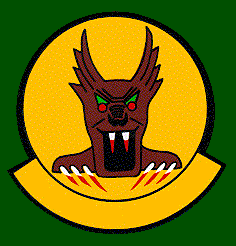
GLOSSARY OF TERMS |
This glossary is to help anybody who doesn't quite know some of the words and terms used in this site. Here is a list and short definition of any such words in as plain english as I can get :)
BUNYIP - An animal of the dreamtime, who could haunt various locations by day or night. For example waterholes and caves. It traditionally is a very ugly and fearsome beast. The United States Army Air Force's 49th Fighter Group - 8th Squadron, used an Aboriginal Bunyip head as it's official logo. This logo is still incidentally still in use with this unit today! In the official 49th Fighter Group book "Protect and Avenge" and the Squadron Signal book "The 49th FG at War" they refer to the bunyip as a 'bunyap'. It is not stated exactly when and why the unit adopted the bunyip as its logo, but the squadron did participate in the defence of Darwin from early to mid 1942. It is also known as "the screaming demon" to the Americans. (I have a model of a P40E Kittyhawk flown by Capt.Bill Hennon, the commander of this squadron during their battles over Australia in 1942, his aircraft features the bunyip in a prominent position on the tail).

The Bunyip or "Screaming Demon" of the 8th Squadron of the USAAF 49th Fighter Group.
CHOCCO - Chocolate Soldier, i.e. they would melt under pressure and in the sun. A derogatory term used in World War Two by AIF volunteers to describe the militia (part-time) soldiers in the AMF. The term was used after the actions of the 39th Battalion on the Kokoda Trail in 1942 as a badge of honour, the term is now used with pride by part-timers.
GAMILAROI - "My mob", the Gamilaroi are one of the largest Aboriginal communities in Australia. There are many variations on the word, the most popular being Kamilaroi and Gamilaraay. Traditionally, my ancestors were from the North Western N.S.W. and the Southern Central Queensland area. Today we are found all throughout the South East of the country, in particular Moree, Narrabri, Tamworth, Armidale, Redfern, Sydney, Mt.Druitt, Newcastle among many!

KOORI - South East Aboriginal term for 'our people' (originally from the Awakabal clan - Central Coast N.S.W). It is the most widely used and known term by our communities. The usage of this word in this site also symbolises the word Murri, Goori, Nunga, Nyoongar, Yolgnu, Koorie and other words used by our communities for us mob. No offence is meant to other Aboriginal or Torres Strait Islander communities.
MISSION - A place where we were herded by the Government so that they and squatters/pastrolists/industry could take the land. The other main type of mission are the Christian missions, where missionaries would convert 'heathen' Aboriginals and Torres Strait Islanders and convert them to their ways. From these missions (commonly known as "the mish") they could keep us un-educated, under control, under-fed and without human rights. During the wars, many men joined from the missions so that they could for the first time in their lives, obtain a full wage, three good meals a day and see the world. The direct equivalent of the North American 'reservation'.
RAAF - Royal Australian Air Force. Many non-Aboriginal servicemen had not had any direct contact with Indigenous Australians before the Second World War. When the Australian Government built new airfields and bases in Northern Australia (often with substantial assistance from the local communities) many thousands of non-Indigenous Aussies had their first 'taste' of Aboriginal culture without the derogatory stereotypes portrayed often in the media and in 'traditional Anglo-Celtic Aussie culture'. Many made good friends with our communities (eg. Alick Jackomos) and brought new found appreciation and respect for Aboriginal people and culture back to the Southern cities and towns. Airfields such as Millingimbi Northern Territory and Horn Island in the Torres Strait.
TRACKERS - Aboriginal and Torres Strait Islanders 'employed' to help the authorities in finding lost people or felons. In World War Two, the immense skills of many recently colonised Northern Aboriginal communities were used to find downed aircrews from the Australia, Dutch and United States Airforce. Also used to maintain a vigil over the vast Northern coastline of Australia in case of Japanese invasion or recconaisance parties. I've used the term 'employed' loosly due to the fact that most of these people were NEVER paid their entitled pay and their services often ignored by the Government
.
USAAF - United States Army Air Force. The former name of what is now known as the United States Air Force (USAF). During World War Two thousands of American aircrews were based in Australia. In particular, the Northern Territory and Northern Queensland (especially Townsville). Many of these men returned back to the States after the war with many boomerangs and other Aboriginal 'tourist art', a forerunner to todays immense Aboriginal cultural industry.